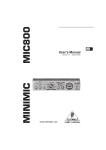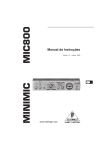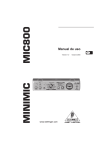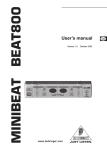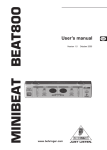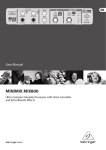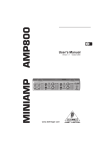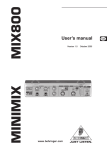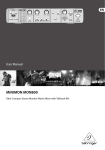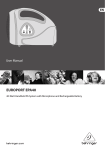Download Behringer Minimic Mic800 User manual
Transcript
User Manual MINIMIC MIC800 Ultra-Compact Microphone Modeling Preamp 2 MINIMIC MIC800 User Manual Table of Contents Important Safety Instructions...............................3 Legal Disclaimer......................................................3 Limited Warranty....................................................3 1. Introduction........................................................4 1.1 Before you begin......................................................4 1.1.1 Shipment..............................................................4 1.1.2 Initial operation.................................................4 1.1.3 Online registration...........................................4 2. Control Elements................................................4 2.1 About using the MIC800.......................................4 2.1.1 MIC800 input......................................................5 2.1.2 MIC800 output...................................................5 2.2 Front panel.................................................................5 2.3 Rear panel..................................................................7 3. Setup Example....................................................8 4. Audio Connections.............................................8 5. Specifications...................................................10 6. Other Mini Products.........................................11 3 MINIMIC MIC800 User Manual Important Safety Instructions Terminals marked with this symbol carry electrical current of sufficient magnitude to constitute risk of electric shock. Use only high-quality professional speaker cables with ¼" TS or twistlocking plugs pre-installed. All other installation or modification should be performed only by qualified personnel. This symbol, wherever it appears, alerts you to the presence of uninsulated dangerous voltage inside the enclosure voltage that may be sufficient to constitute a risk of shock. This symbol, wherever it appears, alerts you to important operating and maintenance instructions in the accompanying literature. Please read the manual. Caution To reduce the risk of electric shock, do not remove the top cover (or the rear section). No user serviceable parts inside. Refer servicing to qualified personnel. Caution To reduce the risk of fire or electric shock, do not expose this appliance to rain and moisture. The apparatus shall not be exposed to dripping or splashing liquids and no objects filled with liquids, such as vases, shall be placed on the apparatus. Caution These service instructions are for use by qualified service personnel only. To reduce the risk of electric shock do not perform any servicing other than that contained in the operation instructions. Repairs have to be performed by qualified service personnel. 1. Read these instructions. 2. Keep these instructions. 3. Heed all warnings. 4. Follow all instructions. 5. Do not use this apparatus near water. 6. Clean only with dry cloth. 7. Do not block any ventilation openings. Install in accordance with the manufacturer’s instructions. 8. Do not install near any heat sources such as radiators, heat registers, stoves, or other apparatus (including amplifiers) that produce heat. 9. Do not defeat the safety purpose of the polarized or grounding-type plug. A polarized plug has two blades with one wider than the other. A groundingtype plug has two blades and a third grounding prong. The wide blade or the third prong are provided for your safety. If the provided plug does not fit into your outlet, consult an electrician for replacement of the obsolete outlet. 10. Protect the power cord from being walked on or pinched particularly at plugs, convenience receptacles, and the point where they exit from the apparatus. 11. Use only attachments/accessories specified by the manufacturer. 12. Use only with the cart, stand, tripod, bracket, or table specified by the manufacturer, or sold with the apparatus. When a cart is used, use caution when moving the cart/apparatus combination to avoid injury from tip-over. 13. Unplug this apparatus during lightning storms or when unused for long periods of time. 14. Refer all servicing to qualified service personnel. Servicing is required when the apparatus has been damaged in any way, such as power supply cord or plug is damaged, liquid has been spilled or objects have fallen into the apparatus, the apparatus has been exposed to rain or moisture, does not operate normally, or has been dropped. 15. The apparatus shall be connected to a MAINS socket outlet with a protective earthing connection. 16. Where the MAINS plug or an appliance coupler is used as the disconnect device, the disconnect device shall remain readily operable. LEGAL DISCLAIMER TECHNICAL SPECIFICATIONS AND APPEARANCES ARE SUBJECT TO CHANGE WITHOUT NOTICE AND ACCURACY IS NOT GUARANTEED. BEHRINGER, KLARK TEKNIK, MIDAS, BUGERA, AND TURBOSOUND ARE PART OF THE MUSIC GROUP (MUSIC-GROUP.COM). ALL TRADEMARKS ARE THE PROPERTY OF THEIR RESPECTIVE OWNERS. MUSIC GROUP ACCEPTS NO LIABILITY FOR ANY LOSS WHICH MAY BE SUFFERED BY ANY PERSON WHO RELIES EITHER WHOLLY OR IN PART UPON ANY DESCRIPTION, PHOTOGRAPH OR STATEMENT CONTAINED HEREIN. COLORS AND SPECIFICATIONS MAY VARY FROM ACTUAL PRODUCT. MUSIC GROUP PRODUCTS ARE SOLD THROUGH AUTHORIZED FULLFILLERS AND RESELLERS ONLY. FULLFILLERS AND RESELLERS ARE NOT AGENTS OF MUSIC GROUP AND HAVE ABSOLUTELY NO AUTHORITY TO BIND MUSIC GROUP BY ANY EXPRESS OR IMPLIED UNDERTAKING OR REPRESENTATION. THIS MANUAL IS COPYRIGHTED. NO PART OF THIS MANUAL MAY BE REPRODUCED OR TRANSMITTED IN ANY FORM OR BY ANY MEANS, ELECTRONIC OR MECHANICAL, INCLUDING PHOTOCOPYING AND RECORDING OF ANY KIND, FOR ANY PURPOSE, WITHOUT THE EXPRESS WRITTEN PERMISSION OF MUSIC GROUP IP LTD. ALL RIGHTS RESERVED. © 2013 MUSIC Group IP Ltd. Trident Chambers, Wickhams Cay, P.O. Box 146, Road Town, Tortola, British Virgin Islands LIMITED WARRANTY For the applicable warranty terms and conditions and additional information regarding MUSIC Group’s Limited Warranty, please see complete details online at www.music-group.com/warranty. 4 MINIMIC MIC800 User Manual 1. Introduction The MINIMIC MIC800 is a modeling preamplifier for instruments and microphones, even studio-grade condenser microphones. The heart of this compact unit is low-noise circuitry that uses discrete components and produces highly transparent sound. Equipped with preamp settings, the MIC800 is an extremely musical tool. It can produce an incredible punch in percussion instruments and give instruments that are rich in upper harmonics more transparency. Sounds are warm, detailed, and brilliant. You get better low-end differentiation, which helps you identify individual instruments. In addition, vocals gain presence and volume without masking other sounds. As a result, voices integrate perfectly into the mix. The innovative VTC (Virtual Tube Circuitry) was developed by our engineering team and lends instruments the unique character of classic tube amps. The MIC800 is also equipped with BEHRINGER’s sophisticated output limiter, which prevents the output signal from being distorted. Additional features like phase inversion, phantom power, 20 dB pad, and low-cut filter make the MIC800 very, very powerful. ◊ Please read the manual carefully and keep it around for future reference. 1.1 Before you begin 1.1.1 Shipment Your MIC800 was carefully packed at the factory, and the packaging was designed to protect the unit from rough handling. Nevertheless, we recommend that you carefully examine the packaging and its contents for any signs of physical damage that may have occurred during transit. ◊ If the unit is damaged, please do NOT return it to BEHRINGER. Instead, notify your dealer and the shipping company immediately. Otherwise, claims for damage or replacement may not be honored. ◊ Always use the original packing carton to prevent damage during storage or transport. ◊ Make sure that no children are left unsupervised with the MIC800 or its packaging. ◊ Please ensure proper disposal of all packing materials. 1.1.2 Initial operation Do not put the MIC800 on any equipment that generates intense heat, for example an amplifier. Ensure that the ventilation openings that are located on the top panel of the MIC800 are not covered or blocked. To power the MIC800, use only the power supply unit that is delivered with your equipment. 1.1.3 Online registration Please register your new BEHRINGER equipment right after your purchase by visiting http://behringer.com and read the terms and conditions of our warranty carefully. Should your BEHRINGER product malfunction, it is our intention to have it repaired as quickly as possible. To arrange for warranty service, please contact the BEHRINGER retailer from whom the equipment was purchased. Should your BEHRINGER dealer not be located in your vicinity, you may directly contact one of our subsidiaries. Corresponding contact information is included in the original equipment packaging (Global Contact Information/ European Contact Information). Should your country not be listed, please contact the distributor nearest you. A list of distributors can be found in the support area of our website (http://behringer.com). Registering your purchase and equipment with us helps us process your repair claims more quickly and efficiently. Thank you for your cooperation! 2. Control Elements This chapter begins with an introduction to using the MIC800. For details about: • using MIC800 features, see 2.2 Front panel • setting up the MIC800, see 2.3 Rear panel ◊ Ensure that only qualified personnel set up and operate the MIC800. 2.1 About using the MIC800 Microphones and instruments such as guitars and basses output low-level signals. However, most types of audio equipment can only process line-level signals, which average +4 dBu for studio equipment and -10 dBV for Hi-Fi and home-recording equipment. For example, you cannot route microphone output directly to a compressor. You need an intermediary piece of audio equipment. This piece of equipment is the MIC800. When the MIC800 receives a low-level signal, the MIC800 immediately raises the signal to line level. Before the MIC800 outputs the line-level signal to another piece of audio equipment, you can: • adjust the level and the polarity of the audio signal • add warmth and other characteristics to the audio signal 5 MINIMIC MIC800 User Manual 2.1.1 MIC800 input 2.1.2 MIC800 output The MIC800 can receive low-level signals from the following types of audio equipment: • microphones that you use to convert vocals and some instrument sounds into electrical energy • DI boxes that you use to input signals from most types of electric instruments (electric guitars and basses, for example) The MIC800 can also receive line-level signals when these signals are also mono signals. Examples of audio equipment that output these mono signals include some types of keyboards and soundcards. In this documentation, the signals that the MIC800 receives are referred to as input signals. The MIC800 can send line-level signals to most types of audio equipment. Some examples include compressors, mixers, multi-track recorders, power amps. In this documentation, the signals that the MIC800 sends are referred to as output signals. (7) (4) (5) (6) (8) (3) 2.2 Front panel This section describes how to use the front panel of the MIC800, illustrated as follows: (1) (2) (9) (10) (11) (12) Fig. 2.1: MIC800 front panel In the previous illustration, each control element is associated with a callout, for example (1). In this section, use these callouts to identify details about each control element. The numeric order of callouts (3) through (12) identifies the signal path of the MIC800. This means that the PHANTOM +48 V button ( (3) ) is the first feature in the signal path. The VU meter ( (12) ) is the last feature in the signal path. About the buttons Some of the MIC800 control elements are buttons. When a button is: • pushed in and illuminated, the relevant feature is turned on • not pushed in and illuminated, the relevant feature is turned off The rest of this section describes how to use the control elements of the MIC800: ◊ Before you turn on the MIC800, turn the INPUT GAIN control to +26 dB (minimum setting). (1) (power) button: To turn the MIC800 on and off, push this button. (2) VTC LED: When you turn on the MIC800, this LED is illuminated. This indicates that the VTC (Virtual Tube Circuitry) is activated. VTC is BEHRINGER analog technology that emulates the warmth of vintage tube circuitry. Here, the term warmth refers to the upper harmonics that tube circuitry adds to audio signals. Upper harmonics give audio signals power, transparency, and unobtrusive brilliance. To adjust the amount of warmth that the MIC800 creates, use the TUBE MODELING control ( (10) ). (3) PHANTOM +48 V button: If you connected a condenser microphone to the MIC800, use this button to turn on phantom power. Phantom power is the + 48 volts that condenser microphones need to polarize condenser diaphragms. Dynamic microphones do not need phantom power. ◊ Before you turn on phantom power, connect your condenser microphone to the MIC800. In addition, mute all loudspeakers. (4) 20 dB PAD button: To reduce the input sensitivity by 20 dB, use this button to turn on the pad. It is not recommended to reduce the input sensitivity for microphone input. (5) Ø (phase inversion) button: If you encounter phase cancellation, use this button to turn on the phase inversion feature. This feature inverts the input signal 180 degrees. Phase cancellations occur when you combine the output signal with other signals and the combined signals cancel each other. (6) INPUT GAIN control: To boost the level of the input signal, turn this control toward +26 dB (minimum setting) or, alternatively +60 dB (maximum setting). Slowly boost the level of the input signal. 6 MINIMIC MIC800 User Manual (7) SIGNAL/CLIP meter: To monitor the status of the input signal, use this meter. At any given time, one of the following LEDs illuminate on this meter: • SIGNAL: The MIC800 receives the input signal. • CLIP: The MIC800 clips the input signal. If this LED: • occasionally illuminates, the MIC800 clips only some peaks in the input signal • constantly illuminates, the MIC800 clips a large part of the input signal. The level of the input signal is too high. ◊ To lower the level of the input signal, use the INPUT GAIN control. If this control is set to + 26 dB (minimum setting) and clipping still occurs, use the 20 dB PAD button to turn on the pad. Preamp models 5-8: WARM To output warm, analog sound, use the WARM settings, described in the following table: Preamp Model 5 KEYBOARD 6 E-GUITAR Warm, acoustic sound, which is ideal for electric guitars 7 VOCAL Warm, consistent sound that has presence and is ideal for vocals 8 VALVE Warm, vacuum tube sound for any kind of signal (8) LOW CUT control: To filter floor rumble and other low-frequency sounds, turn this control toward 15 Hz (minimum filtering) or, alternatively 360 Hz (maximum filtering). (9) PREAMP MODELING control: To select a preamp Preamp models 9-12: WARM-LIMITER Use the WARM-LIMITER settings that are described in the following table to: model, turn this control, which includes several groups of preamp models. • About the preamp models Sometimes an audio signal lacks characteristics that you need. For example, vocals lack consistency or bass lacks fullness. The shape of the audio signal is not correct. On the MIC800, you select the preamp model that describes the characteristics you need. The MIC800 reshapes the audio signal for you. • BEHRINGER created many of the preamp models for specific input sources (guitars, vocals, and so on). However, these models might not meet your needs for a specific environment or for a specific application. Consider the preamp models a starting point in the sound shaping process. Experiment with them. Create your own, unique sound. Details about each group of preamp models follow. Preamp models 1-4: NEUTRAL To output pure, natural sounds, use the NEUTRAL settings, described in the following table: Preamp Model 1 NEUTRAL Description Pure, natural sound 2 VOCAL Natural but crisp sound, which is ideal for vocals 3 GUITAR Natural but bright sound, which is ideal for guitars 4 BASS Natural but full sound, which is ideal for bass guitars Description Warm, round sound, which is ideal for keyboards output warm, analog sound that gives low tones fullness and presence limit high volumes and signal peaks Preamp Model 9 MULTI Description Warm analog sound for any kind of signal 10 VOCAL Warm, full sound that is consistent and ideal for vocals 11 A-GUITAR Warm, soft sound that is lively and ideal for acoustic guitars 12 PIANO Warm, soft sound that sparkles and is ideal for pianos Preamp models 13-16: LIMITER Use the LIMITER settings that are described in the following table to: • • output smooth, consistent sound that gives low tones fullness and presence limit high volumes and signal peaks Preamp Model 13 BASS Description Round, rich bass sound, which is ideal for bass guitars 14 A-GUITAR Full, soft sound, which is ideal for acoustic guitars 15 PERCUSSION Precise, punchy sound, which is ideal for percussion instruments 16 LIMITER Compact sound for vocals and all other types of signals 7 MINIMIC MIC800 User Manual (10) TUBE MODELING control: To adjust the amount of tube 2.3 Rear panel (11) OUTPUT LEVEL control: To adjust the level of the output signal, This section describes how to use the rear panel to set up the MIC800. ◊ Before you set up the MIC800, turn off the MIC800. In addition, turn the INPUT GAIN control to +26 dB (minimum setting). The following illustrates the rear panel of the MIC800: warmth that the MIC800 adds to the input signal, turn this control toward COLD (minimum setting, no warmth) or toward HOT (maximum warmth). For details about tube warmth, see (2) VTC LED. turn this control toward -∞ dB (no output signal) or toward +10 dB (maximum level). (12) VU meter: To monitor the average level of the output signal, use this vintage style meter, which includes a dB scale. Because the standard operating level for audio equipment is 0 (zero) dB, this is the optimal level for the output signal. At 0 dB, the MIC800 still has approximately 15 dB of headroom. (17) (13) (14) (15) (16) Fig. 2.2: MIC800 rear panel In the previous illustration, each control element is associated with a callout, for example (1). In the following section, use these callouts to quickly identify details about each control element: (13) POWER connector: To power the MIC800, connect the power supply unit to this connector. The power supply unit is delivered with the MIC800. ◊ When you finish using the MIC800, unplug the power supply unit from the power source. As long as the power supply unit is connected to a power source, the power supply unit consumes energy. (14) OUTPUT LINE connector: To output an audio signal from the MIC800, use this ¼" TS (unbalanced) connector. As the previous illustration shows, the MIC800 includes 2 input connectors ( (15) and (16) ). ◊ It is not recommended to simultaneously use both input connectors. (15) INPUT LINE connector: To input a line-level signal to the MIC800, use this ¼" TRS (balanced) connector. The line-level signal must also be a mono signal. For details, see 2.1.1 MIC800 input. ◊ If the connector on the line-level source is balanced and you insert an unbalanced, ¼" TS plug, the signal level will decrease 6 dB. To raise the signal level, use the INPUT GAIN control ((5) ). (16) INPUT MIC connector: To input a low-level signal to the MIC800, use this XLR (balanced) connector. The low-level signal must also be a mono signal. For details, see 2.1.1 MIC800 input. ◊ When you set up with a condenser microphone, do the following: a. Via the INPUT MIC connector, connect your condenser microphone to the MIC800. b. Mute all loudspeakers. c. To turn on phantom power, use the PHANTOM +48 V button. d. Wait several seconds for the phantom power to charge the condenser diaphragm. (17) SERIAL NUMBER: To register the MIC800, use this unique serial number. For details about audio plugs, see 4. Audio Connections. 8 MINIMIC MIC800 User Manual 3. Setup Example The following example illustrates the role of the MIC800 in your audio setups: Input ULTRAVOICE XM1800S MINIMIC MIC800 Output PRO MIXER VMX100USB Fig. 3.1: Setup example About setting up with other MINI products The MIC800 belongs to the MINI suite of BEHRINGER products. You can set up the MIC800 with these products. For details, see 6. Other Mini Products. 4. Audio Connections This chapter provides details about the plugs that you can use to connect microphones and other audio equipment to the MIC800. For microphones To connect microphones to the MIC800, use a microphone cable that includes balanced XLR plugs. The following illustrates the MIC800 connector (Input) and the corresponding XLR plug (Output): Balanced use with XLR connectors 2 1 3 input 1 = ground/shield 2 = hot (+ve) 3 = cold (-ve) 1 2 3 output For unbalanced use, pin 1 and pin 3 have to be bridged Fig. 4.1: Balanced XLR connector and plug 9 MINIMIC MIC800 User Manual For other audio equipment To connect instruments and other types of equipment to the MIC800, use ¼" TS or ¼" TRS plugs, illustrated as follows. For details about MIC800 connectors, see 2.3 Rear panel. tip signal sleeve ground/shield tip hot (+ve) ring cold (-ve) sleeve ground/shield tip ring sleeve strain relief clamp tip sleeve strain relief clamp strain relief clamp sleeve strain relief clamp ring tip sleeve tip sleeve ground/shield tip signal Fig. 4.2: Patch cord with unbalanced, ¼" TS plugs sleeve ground/shield ring cold (-ve) tip hot (+ve) Fig. 4.3: Patch cord with balanced, ¼" TRS plugs 10 MINIMIC MIC800 User Manual 5. Specifications Mic Input Controls Type XLR connector (balanced) INPUT GAIN +26 dB to +60 dB Impedance approx. 2.6 kΩ (balanced) LOW CUT 15 to 360 Hz Max. input level -2 dBu, +18 dBu with pad OUTPUT LEVEL -∞ dB to +10 dB Line Input Power Supply Type ¼" TRS connector (balanced) Impedance approx. 20 kΩ (balanced) Max. input level +19 dBu, +28 dBu with pad Output Mains connection external power supply, 9 V~ / 750 mA Mains Voltage USA/Canada 120 V~, 60 Hz U.K./Australia 240 V~, 50 Hz Type ¼" TS connector (unbalanced) China 220 V~, 50 Hz Impedance approx. 130 Ω Europe 230 V~, 50 Hz Max. output level +15 dBu Japan 100 V~, 50 - 60 Hz Power consumption System Specifications Frequency response MIC: 10 Hz to 90 kHz, ±3 dB LINE: 10 Hz to 67 kHz, ±3 dB Dynamic range 100 dB, 20 Hz to 20 kHz Distortion 0.016% typ. @ -16 dBu input Signal-to-noise ratio: 86 dBu @ +4 dBu, a-weighted Buttons PAD 20 dB Ø (phase inversion) 180° PHANTOM power +48 V approx. 5 W Dimensions/Weight Dimensions (H x W x D) approx. 48 x 120 x 243 mm (1.89 x 4.72 x 9.55") Weight approx. 0.58 kg (1.28 lbs) BEHRINGER constantly strives to maintain the highest quality standards. Modifications may be made, if necessary, without prior notice. The specifications and appearance of the equipment may therefore differ from those listed or illustrated. 11 MINIMIC MIC800 User Manual 6. Other Mini Products The MINIMIC belongs to the MINI suite of BEHRINGER products, which can operate together and are introduced below: MINIFEX FEX800 Ultra-compact 9.5" stereo multi-effects processor for studio and stage applications • 16 awesome FX presets in 24-bit/48 kHz resolution including reverb, delay, chorus, flanger, phaser, rotary speaker, pitch shifter and multi-effects • Intuitive FX Preset control with LED’s indicating the selected program MINIAMP AMP800 Ultra-compact 9.5" headphones amplifier system for studio and stage applications • 4 totally independent stereo high-power amplifier sections • Highest sonic quality even at maximum volume MINIMON MON800 Ultra-compact 9.5" monitor matrix mixer for studio and stage applications • Dedicated input section with 4 selectable and mixable stereo inputs • Accurate 6-digit LED main stereo output meters for precise level indication MINIFBQ FBQ800 Ultra-compact 9.5" graphic equalizer for studio and stage applications • Revolutionary FBQ Feedback Detection System instantly reveals critical frequencies and can also be used as Audio Analyzer • Additional Low Cut filter removes unwanted frequencies, e. g. floor rumble MINIMIX MIX800 Ultra-compact 9.5" karaoke machine for studio and stage applications • Revolutionary Voice Canceller—effectively eliminates vocals from any stereo source while retaining most music elements • Integrated digital echo/reverb processor in 24-bit/40 kHz resolution for ultimate vocal enhancement Fig 6.1: MINI products stack on top of each other We Hear You












